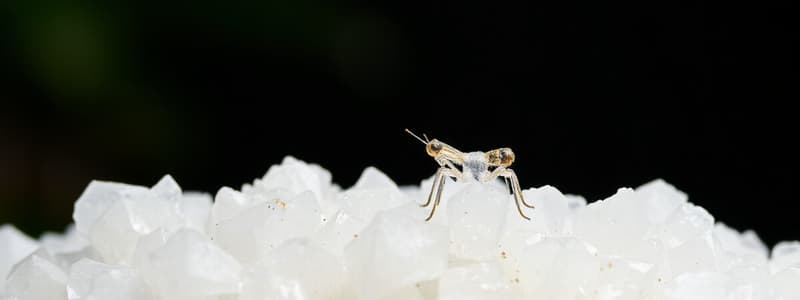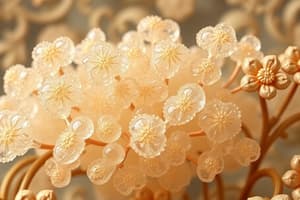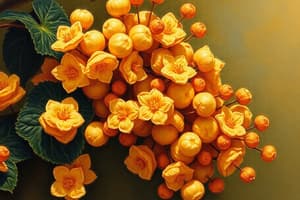Podcast
Questions and Answers
What is the primary function of CamScanner?
What is the primary function of CamScanner?
- Creating presentations
- Document scanning and management (correct)
- Editing video files
- Downloading music files
Which feature is most likely NOT associated with CamScanner?
Which feature is most likely NOT associated with CamScanner?
- Optical character recognition
- Cloud storage integration
- Video conferencing (correct)
- Document sharing
When using CamScanner, what is a key benefit of optical character recognition?
When using CamScanner, what is a key benefit of optical character recognition?
- It converts scanned images into editable text. (correct)
- It reduces file size significantly.
- It allows for video editing capabilities.
- It enhances image quality automatically.
Which of the following is an advantage of using CamScanner for document management?
Which of the following is an advantage of using CamScanner for document management?
What type of files can be processed using CamScanner?
What type of files can be processed using CamScanner?
Flashcards
What is CamScanner?
What is CamScanner?
CamScanner is a mobile app that allows users to scan documents using their smartphone's camera and create digital copies.
What formats does CamScanner support?
What formats does CamScanner support?
CamScanner can convert physical documents into PDF, JPG, or other formats.
What are some features of CamScanner?
What are some features of CamScanner?
CamScanner offers features like document editing, annotation, and sharing, making it a versatile tool for digital organization.
How does CamScanner help with document organization?
How does CamScanner help with document organization?
Signup and view all the flashcards
Where are CamScanner documents stored?
Where are CamScanner documents stored?
Signup and view all the flashcards
Study Notes
Carbohydrate Structure and Function
- Carbohydrates are polyhydroxy aldehydes or ketones or compounds that yield these upon hydrolysis. Their general formula is Cn(H2O)n. For example, glucose has the formula C6H12O6.
- Carbohydrates are classified by the number of sugar units:
- Monosaccharides: single sugar units (e.g., glucose, fructose, galactose). They cannot be further hydrolyzed.
- Disaccharides: two monosaccharides linked together (e.g., sucrose, lactose).
- Oligosaccharides: 3-10 linked monosaccharides.
- Polysaccharides: more than 10 linked monosaccharides (e.g., starch, glycogen, cellulose).
- Monosaccharides are further categorized by functional groups:
- Aldoses: contain an aldehyde group (-CHO)
- Ketoses: contain a ketone group (>C=O)
- Monosaccharides are also classified by the number of carbon atoms (e.g., trioses, tetroses, pentoses, hexoses).
- Sugar acids are formed by oxidizing sugars.
- Mild oxidation produces aldonic acids.
- Moderate oxidation produces uronic acids.
- Strong oxidation produces saccaric acids.
- Glycosides are formed when the anomeric carbon of a monosaccharide bonds with a non-carbohydrate component (aglycone).
Types of Carbohydrates
- Homopolysaccharides: contain only one type of monosaccharide unit (e.g., starch, glycogen, cellulose).
- Heteropolysaccharides: contain more than one type of monosaccharide unit.
- Glycosaminoglycans (GAGs): are heteropolysaccharides including sulfated glycosaminoglycans. Examples include Hyaluronic acid, chondroitin sulfate, dermatan sulfate and keratan sulfate. They are important structural components and lubricants in connective tissues.
- Heteropolysaccharides: Other types include glycolipids and glycoproteins.
Derived Carbohydrates
- Derived carbohydrates are formed from carbohydrates via chemical reactions.
- Sugar alcohols: produced by reducing sugars (e.g., glucose to sorbitol).
- Sugar acids: produced by oxidizing sugars.
Importance of Specific Sugars
- Glucose: A major energy source, important for cellular respiration, nerve function.
- Fructose: A sweet sugar found in fruits, honey. Used to create energy.
- Galactose: Part of lactose, important structural component of glycolipids and glycoproteins. Converted to glucose in the liver.
- Mannose: Found in glycoproteins and glycolipids.
Important Disaccharides
- Sucrose: Table sugar, composed of glucose and fructose.
- Lactose: Milk sugar, composed of glucose and galactose.
- Maltose: A disaccharide formed during starch digestion.
Studying That Suits You
Use AI to generate personalized quizzes and flashcards to suit your learning preferences.




